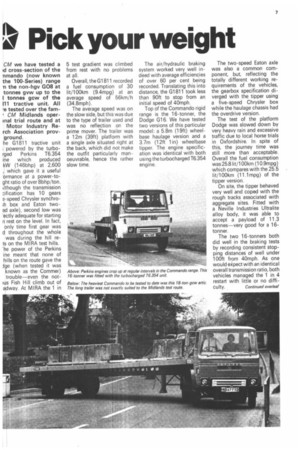Pick your weight
Page 129

Page 130

If you've noticed an error in this article please click here to report it so we can fix it.
CM we have tested a id cross-section of the nmando (now known the 100-Series) range n the non-hgv G08 at tonnes gvw up to the I tonnes gcw of the Ill tractive unit. All -e tested over the famCM Midlands °permal trial route and at
Motor Industry Rerch Association provground. .
he G1811 tractive unit powered by the turborged Perkins T6.354 me which produced kW (146bhp) at 2,600 , which gave it a useful ormance at a power-toght ratio of over 8bhp/ton. klthough the transmission :s.ification has 10 gears a-speed Chrysler synchroih box and Eaton two ad axle), second low was 'ectly adequate for starting n rest on the level. In fact, only time first gear was d throughout the whole was during the hill rets on the MIRA test hills. he power of the Perkins me meant that none of hills on the route gave the ige (when tested it was known as the Commer) trouble—even the notus Fish Hill climb out of adway. At MIRA the 1 in 5 test gradient was climbed from rest with no problems at all.
Overall, the G1811 recorded a fuel consumption of 30 lit/100km (9.4mpg) at an average speed of 56km/h (34.8mph).
The average speed was on the slow side, but this was due to the type of trailer used and was no reflection on the prime mover. The trailer was a 12m (39ft) platform with a single axle situated right at the back, which did not make the outfit particularly manoeuvrable, hence the rather slow time. The air/hydraulic braking system worked very well indeed with average efficiencies of over 60 per cent being recorded. Translating this into distance, the G1811 took less than 90ft to stop from an initial speed of 40mph.
Top of the Commando rigid range is the 16-tonner, the Dodge G16. We have tested two versions of this particular model: a 5.8m (1911) wheelbase haulage version and a 3.7m (1211 1in) wheelbase tipper. The engine specification was identical with both using the turbocharged T6.354 engine. The two-speed Eaton axle was also a common component, but, reflecting the totally different working requirements of the vehicles, the gearbox specification diverged with the tipper using a five-speed Chrysler box while the haulage chassis had the overdrive version.
The test of the platform Dodge was slowed down by very heavy rain and excessive traffic due to local horse trials in Oxfordshire. In spite of this, the journey time was still more than acceptable. Overall the fuel consumption was 25.8 lit/100km (10.9mpg) which compares with the 25.5 lit/100km (11.1mpg) of the tipper version.
On site, the tipper behaved very well and coped with the rough tracks associated with aggregate sites. Fitted with a Neville Industries Ultralite alloy body, it was able to accept a payload of 11.3 tonnes—very good for a 16tonner.
The two 16-tonners both did well in the braking tests by recording consistent stopping distances of well under 10011 from 40mph. As one would eipect with an identical overall transmission ratio, both vehicles managed the 1 in 4 restart with little or no diffi
culty. Continued overleaf The first Commando to be tested by Commercial Motor was the 8.5-ton G8675 back in 1974 shortly after the announcement of the range. Although the power unit was also a Perkins, it was the naturally aspirated version of the six-cylinder 354 Series already described. As fitted to the Commando, it developed 76kW (101bhp) net installed at 2,800rpm. With the 4.6m (15ft) Welford steel dropside body fitted, the 3.5m (lift 4in) wheelbase chassis carried a 4.9-tonne payload.
The Chrysler-built fourspeed gearbox had a good ratio spread which permitted a restart on a 1 in 4 gradient while still allowing a speed of 60mph to be maintained on motorways. Overall fuel consumption for the 312km (194 miles) of the Midlands test route was 18.9 lit/100km (14.9mpg) while the motorway section showed an exceptionally good result of 20.9 lit/100km (13.5mpg) for the very high average speed of 94km/h (58.5mph).
The 7.5-tonne-gvw category has been the subject of a great deal of attention from the volume manufacturers since the change in hgv licence requirements a few years ago. The Chrysler contribution to this important market sector is the G08, again Perkins powered with the naturally aspirated 6.354 engine.
The choice of axle ratio (5.14 to 1) rather hampered the Dodge's performance as far as fuel consumption was concerned, but at least it meant that the hill climbing ability was second to none. Overall, the G08 recorded 21 lit/100km (13.4mpg) which Chrysler felt could have been bettered with the optional 4.875 axle -ratio. But then the vehicle probably would not have climbed the 1 in 3 test gradient successfully as this one did. If nothing else, this test emphasised the importance of selecting the correct transmission specification for the job in hand.
I have kept the comments relating to the cab until last because obviously the cab is a common component shared by all the Dodges/Commers tested. In terms of engine accessibility, the Commando tilt cab has got to be one of the best on the market for the weight range it covers. It must certainly rank as one of the easiest and quickest to tilt. Operation is by hand with the aid of counter-balancing and not by hydraulic means, giving a maximum angle of around 45 degrees. The resultant engine access is superb.
• by Graham Montgomerie
























































































































































